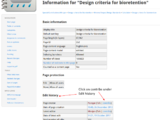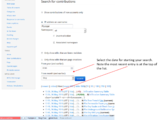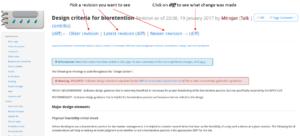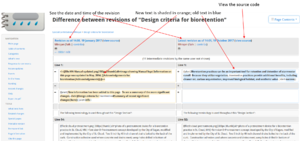
Finding earlier page versions and edits of and referencing the Minnesota Stormwater Manual Revision as of 23:41, 6 December 2022 by Mtrojan (talk | contribs) (→Citing the Minnesota Stormwater Manual)
The wiki format for the Minnesota Stormwater Manual allows for continual updates. While this has the advantage of keeping the information in the manual aligned with the most recent advances and information on stormwater management, it creates challenges for project leads, engineers, developers, and others who comply with specifications in the manual. Specifications may change from one project to the next. Local regulations, such as ordinances, may refer to the manual, which creates either a challenge of keeping on top of changes in the manual or having to refer to a specific version of the manual.
The MPCA recommends that older guidance, such as the 2005 or 2008 Minnesota Stormwater Manual (Version 2.X or earlier) and the Stormwater Best Management Practices Manual (Protecting water quality in urban areas), not be used in stormwater development projects or be incorporated into local regulations and ordinances. Significant advances in BMP design, construction, maintenance, and performance require using recent information.
This page describes some options for addressing the problem of using and referencing the Minnesota Stormwater Manual.
Contents
Finding the last date when a page was updated
At the bottom of each page is a statement identifying the date and time of the most recent update to the page. Another option is to click on Page information in the left toolbar. This opens a page listing the date of latest edit, as well as other information about the page.
Finding an earlier version of a page in the manual
The wiki retains copies of all edits (changes) to the manual. However, it can be challenging to find the specific page and date of interest. Follow the procedure below to identify updates of interest.
- Click on Page information in the left toolbar
- Under Edit history, click on contribs
- In the search tool for your browser, type the text you want. If you want to find a specific page, type the name of that page into the browser search box.
- Recommended: Scroll to the bottom of the page and click on 500. This will display 500 results per page.
- Scroll back to the top of the page and select a month and year of interest, then click search. The list of page versions starts with the most recent. In your browser search box, search for the text of interest on the page with your list. If it does not appear, you can go back or forward in time to find a version of interest. Scroll to the bottom of the page and click on either newer 500 or older 500, depending on which direction in time you wish to go. Continue this search until you find the item of interest.
- Manual editors can view individual page histories. If you are interested in a specific version or date, contact a manual editor.
The image gallery below illustrates this process for the manual page called Design criteria for bioretention.
- Screen shots showing how to retrieve earlier versions of a manual page. See steps described above.
What does an earlier version look like in the wiki?
Using the manual page called Design criteria for bioretention as an example, assume we are looking at the January 19, 2017 version of this page. The image to the left shows a screen shot of the resulting page. Note the arrows in this image were added to point out the features of this page. You can select from different versions immediately before or after the selected version. To see the difference between two versions, click on the diff link. A screen shot in the image to the right shows that two versions are laid next to each other to allow comparisons of text that has been added (orange shading) or deleted (blue shading). You can view the source coding by clicking on view source. Note that each version also includes information on the date and time the revision was created and the name of the person who made the revisions. A link to all stormwater manual revisions is included (shown as contribs, which was discussed in the previous section).
Options for referencing a manual version
There are options for referencing a version of the Minnesota Stormwater Manual. For example, an ordinance might state "design specifications must conform to the Minnesota Stormwater Manual". Example language for this scenario is included in the option discussions below.
- Option 1: Reference the most recent version of the manual. Example language would be "design specifications must conform to the current version of the Minnesota Stormwater Manual". An advantage of this option is that the most current information will be used. A disadvantage is that manual updates occur often and may occur for a single project during the life of that project.
- Option 2: Reference the manual version that existed at the start of a project. Example language would be "design specifications must conform to the version of the Minnesota Stormwater Manual at the start of the project". This language would not result in changes during the life of a project. A disadvantage is that project leads and developers will have to determine if changes occurred since their last project.
- Option 3: reference the manual at a specific point in time. Example language would be "design specifications must conform to the January 1, 2017 version of the Minnesota Stormwater Manual". This prevents shifting requirements over time and does not require the project lead or developer to determine if recent versions of the manual exist. A disadvantage is that the project lead or developer must find the appropriate version of the manual using the methods described above. Also, the concern with outdated information becomes an issue over time.
Citing the Minnesota Stormwater Manual
As a point of clarification, citing the manual, such as in a document, differs from the discussion above in which a version of the manual or manual page is being referenced. Guidance for citing the manual can be accessed by clicking on Cite this page under Tools in the left toolbar.
This page was last edited on 6 December 2022, at 23:41.





